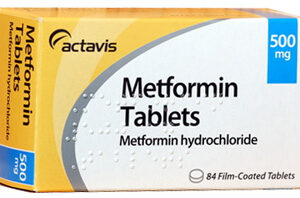About Metformin
Metformin is an oral antidiabetic medication that is primarily used to treat type 2 diabetes. It belongs to a class of drugs known as biguanides, which act by decreasing glucose production in the liver and improving insulin sensitivity, thereby enhancing glucose uptake by tissues.
Chemical Composition
Metformin hydrochloride is the full chemical name, with its molecular formula being C4H11N5•HCl. It is a white to off-white crystalline compound with a pKa of 12.4.
Indications for Use
Metformin is indicated for the management of type 2 diabetes mellitus in adults and children over the age of 10 years. It may be used as monotherapy or in combination with other oral antidiabetic agents or insulin. Metformin is also used in the management of polycystic ovary syndrome (PCOS) and has been investigated for use in cancer prevention, management of gestational diabetes, and treatment of obesity in the absence of diabetes.
Dosage Forms and Strengths
Metformin is available in multiple dosage forms including immediate-release (IR) tablets, extended-release (ER) tablets, and oral solutions. The immediate-release tablets are available in strengths of 500 mg, 850 mg, and 1000 mg. The extended-release tablets come in 500 mg, 750 mg, and 1000 mg strengths. Oral solutions are typically available in a 500 mg/5 mL concentration.
Pharmacokinetics and Metabolism
After oral administration, metformin absorption is saturable and incomplete. It is not metabolized in the liver or any other tissues, and is excreted unchanged in the urine. Metformin has an oral bioavailability of 50-60% under fasting conditions. Its plasma protein binding is negligible. The drug’s elimination half-life is roughly 17.6 hours, and its renal clearance is 400-500 mL/min.
Administration Guidelines
Metformin should be taken with meals to reduce gastrointestinal side effects. The dosage should be adjusted based on glycemic control and tolerance, up to a maximum recommended dose. For immediate-release tablets, the typical starting dose is 500 mg orally twice a day or 850 mg once a day. For extended-release tablets, the starting dose is usually 500 mg once daily with the evening meal. The dose should be gradually titrated to reduce gastrointestinal side effects.
Risk of Lactic Acidosis
Metformin can cause a rare but serious condition called lactic acidosis, particularly if the patient has renal impairment, liver disease, or heart failure, or if they consume excessive alcohol. It is contraindicated in patients with severe renal impairment, acute or chronic metabolic acidosis, including diabetic ketoacidosis, and in conditions associated with hypoxemia.
Monitoring Parameters
Before initiating metformin therapy, and at least annually thereafter, renal function should be assessed with laboratory testing. More frequent monitoring may be required for patients with an increased risk of developing renal impairment, such as the elderly. Blood glucose and glycated hemoglobin (HbA1c) levels should be monitored to determine the therapeutic response. Vitamin B12 levels should be assessed periodically during long-term treatment to detect possible deficiency.
Potential Drug Interactions
Metformin can interact with several other medications. Concomitant use of drugs that affect renal function or represent a risk of renal impairment (such as NSAIDs, ACE inhibitors, or diuretics) may increase the risk of lactic acidosis. Alcohol can potentiate the effect of metformin on lactate metabolism. Iodinated contrast media used in certain radiologic investigations may increase the risk of lactic acidosis and should be used with caution.
Special Population Considerations
In pregnant women, metformin may be used if the potential benefit justifies the potential risk to the fetus. For breastfeeding mothers, caution is advised since it is excreted into breast milk and may affect the infant. Pediatric use should be guided by similar adult considerations but starting at lower dosages. In geriatric patients, cautious dosage selection is crucial, often starting at the low end of the dosing range.
Storage and Handling
Metformin should be stored at room temperature between 20 to 25°C (68 to 77°F). The medication should be kept in its original container, protected from moisture and light. All medications should be kept out of the reach of children.
Disposal of Unused Medication
Unused or expired metformin should be disposed of in accordance with official guidelines to protect the environment and prevent drug misuse. It should not be flushed down the toilet or thrown into household trash. Instead, utilize community drug take-back programs or consult with a pharmacist for disposal instructions.





Reviews
There are no reviews yet.